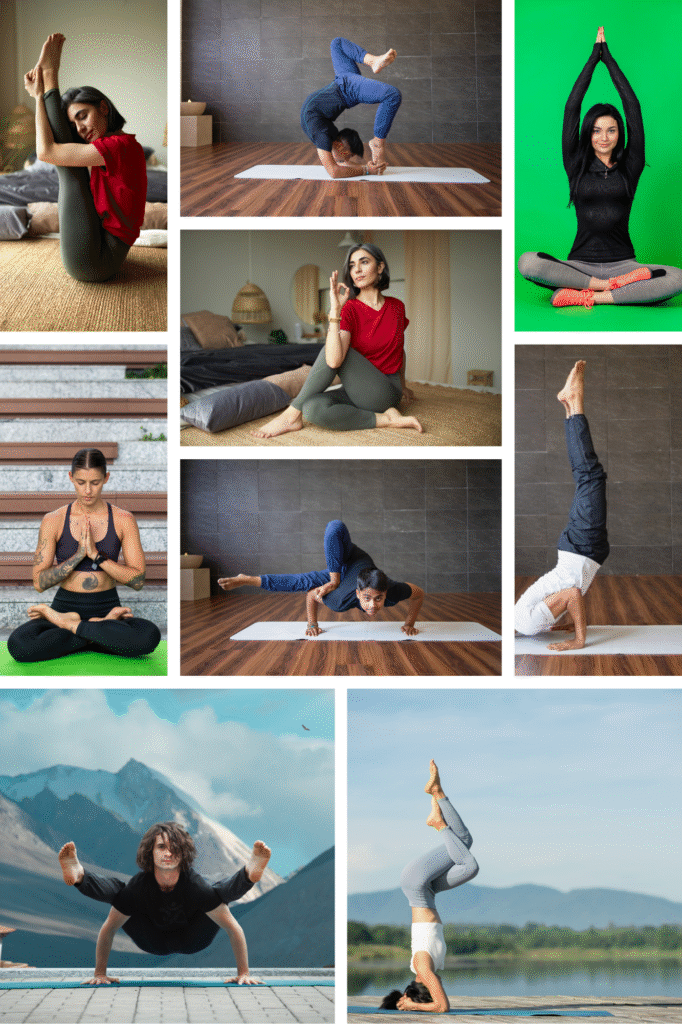Yoga Enucleate
It Originally created as a spiritual route to achieve self-realization and inner enlightenment, it has become quite popular in modern times for its physical benefits, particularly as a stress-reduction and mild exercise method. Although it comes in a variety of forms, all of them are based on the principles of conscious breathing and asanas, or prescribed physical postures. Breathing and attentiveness are the main focus of each pose. Regular yoga practice has been linked to numerous health advantages, according to research. It can help control blood pressure, strengthen muscles, and strengthen the heart. Yoga is well known for its ability to reduce mental tension and for enhancing the quality of sleep.Over time, yoga practitioners frequently report feeling happier and more contented as well as having reduced stress levels. This is primarily due to the fact that attention to posture and breathing, which serves as a kind of meditation. It’s traditional methods date back over 5,000 years. Discipline, intelligence, accuracy, devotion, and commitment are all fostered by yoga. The Sanskrit term “yoga” means “to join or unite,” signifying the union of the body and the mind. Its three main components are meditation (dhyana), breathing exercises (pranayama), and physical postures (asanas).Strength, flexibility, balance, and coordination are all tested in this poses, which enhances your physical capabilities and general well-being. Breathing exercises improve mental and physical performance by strengthening the bond between the body and mind. The body and mind can be better prepared for meditation by concentrating on deliberate breathing and regulated movements. It produces a peaceful state of mind, providing respite from stress and the cacophony of daily living. It develops into a strong and sophisticated discipline that promotes mental clarity, emotional stability, and physical health with consistent practice.
Typs of Yoga

It’s comes in a wide variety of forms, each with its own distinct emphasis and methodology. Yin, Vinyasa, Iyengar, Hatha, and Bikram yoga are a few of the most well-known.
Health Benefits
Asanas positions help you become more flexible and strong while also reducing stress and promoting mental quiet. Every posture benefits your muscles, joints, skin, and every part of your body, including your brain, breathing, internal organs, bones, glands, and nerves. The primary focus of yoga’s physical components is on breath control and posture. The following are some of the main health advantages of yoga poses: 1.Increased breathing and lung capacity 2.Better posture and balance 3.Stress reduction and mental clarity 4.Support for a healthy digestive and circulatory system To put it simply, it make you feel better on the inside as well as the outside.
The benefits of yoga for the musculoskeletal system :
It facilitates the full range of motion in your joints, increasing mobility and easing tension or stiffness. Stretching gently increases flexibility by releasing tense muscles and joints. Over time, maintaining specific poses also increases stamina and strength. When practiced under the supervision of a certified yoga instructor and a medical expert, certain weight-bearing yoga poses can help prevent osteoporosis and even aid those who already have it. Over time, it can ease back discomfort and enhance posture, which will make daily tasks more pleasant and easy.
Heart Health (Heart and Arteries) – Yoga poses are often isometric, meaning they involve holding muscle tension for several seconds to minutes. This type of practice can improve heart health and boost blood circulation. Studies have shown that regular yoga practice may help maintain healthy blood pressure levels.
Yoga Related to Human Age

Everyone can participate in yoga lessons, from total novices to more experienced practitioners. They are appropriate for people of all ages and fitness levels and are not competitive. A competent yoga instructor will closely monitor you, offer guidance, and assist you in modifying poses as necessary. Crucial Safety Information: No yoga pose should ever hurt. Avoid a pose completely or ease out of it gradually if you experience any pain or discomfort. Always pay attention to your body and respect your boundaries.Before beginning a new or regular fitness regimen, it’s a good idea to consult your doctor or another competent health expert if you’re over 46 or over 60, haven’t worked out in a while, or have any pre-existing medical concerns. The Significance of Pre-Exercise Screening Some folks may require more attention before beginning any physical activity. Pre-exercise screening assists in identifying people who could be more susceptible to health problems when engaging in physical activity. This aids in deciding whether exercise has more advantages for you than disadvantages and whether you need more individualized guidance from a medical expert.What to anticipate in the classroom: With 9 to 18 students, yoga classes typically allow the instructor to provide individualized attention. Remember these pointers to get the most of your class: Since many postures require sitting or lying down, dress comfortably and bring a mat or blanket. Don’t eat right before class. Allow ample time for your digestion. Inform your instructor ahead of time if you have any particular health issues, such as pain or discomfort. They can advise you on which positions to avoid, make changes, or, if necessary, refer you to a medical expert. Particular Points to Remember:Particular Points to Remember: Always let your yoga instructor know if you have high blood pressure, heart problems, osteoporosis, are pregnant, have recently been hurt or ill, or are recuperating from surgery. This enables them to safely lead you. Avoid talking during class as it can disrupt both your own and other people’s focus.

